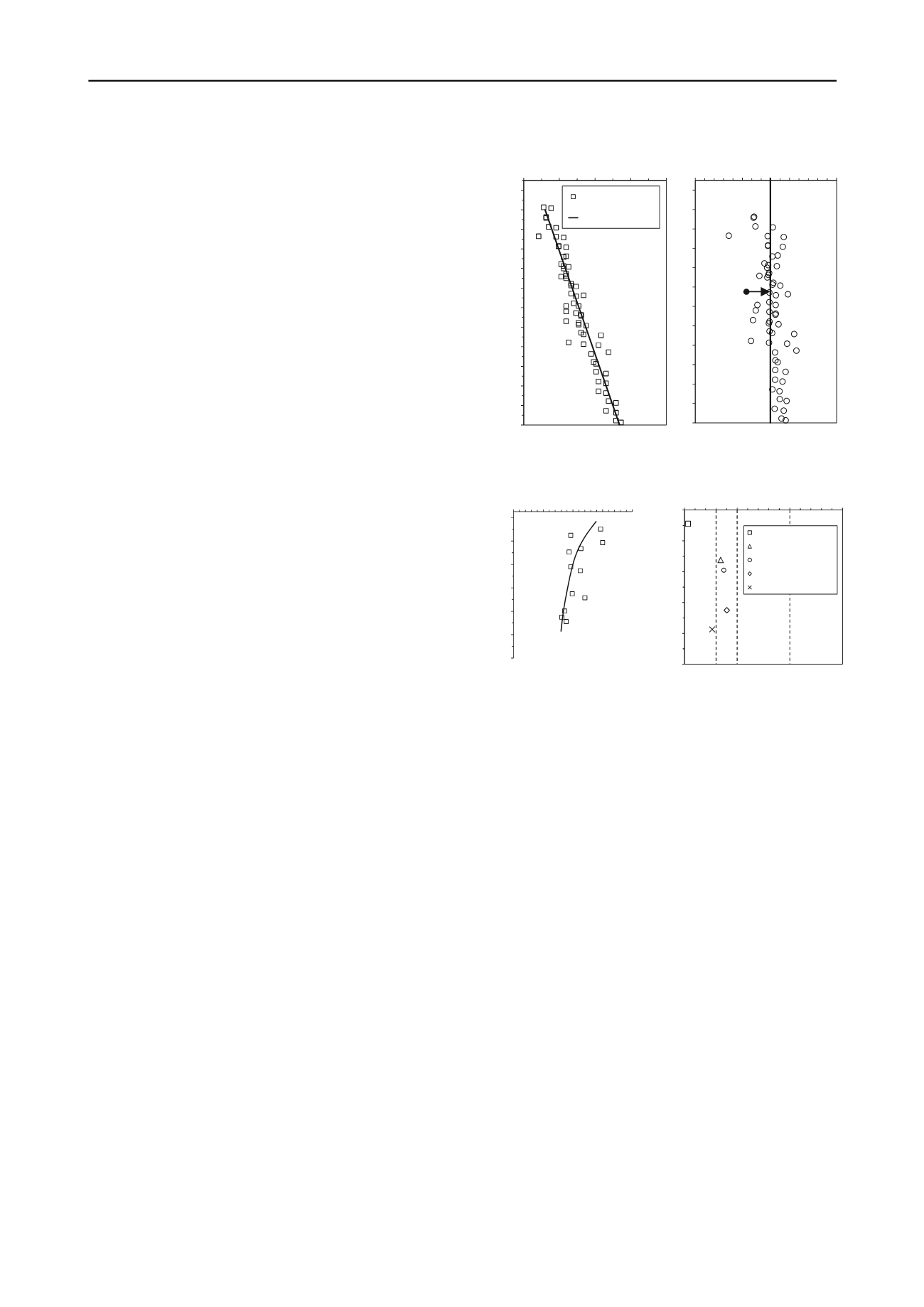
2926
Proceedings of the 18
th
International Conference on Soil Mechanics and Geotechnical Engineering, Paris 2013
overconsolidated soils present in the underlying Tauranga
Group alluvium.
In the Causeway Section, the depth of the Holocene layer is
typically 12.0m to 13.0m, with a reduced depth of 1.5m where
the ECBF rock head is present at a shallow depth.
4 UNDRAINED SHEAR STRENGTH
The undrained shear strength was assessed by in-situ testing
methods such as: (a) field shear vanes; and (b) piezocones
(CPTu).
The field shear vanes are commonly used to determine the
undrained shear strength (s
u
) of soft to medium stiff clays. In
this project, a typical field vane was used with a diameter of 50
to 65mm and a height to diameter ratio of 2.
The piezocone testing was conducted using a standard cone:
cone angle of 60 degrees, a cross-sectional area of 10 cm
2
, and a
porous element located immediately behind the cone. The cone
was advanced during field probing at a standard rate of
20mm/sec. The data was measured electronically to include the
tip resistance (q
c
), sleeve friction (f
s
) and the penetration pore
water pressure (u). The cone correction factor (N
k
) for
estimatesof s
u
values, was assessed based on correlations
against the field shear vane test results.
The shear vane profile for the virgin AH soil is presented in
Figure 1a. All shear vane readings were corrected adopting the
empirical correction factor (
) recommended by (Bjerrum
1973). The undrained shear strength is showing an increasing
trend with depth in accordance with a linear relationship that
can be expressed as follows:
depth
s
u
9.16
(1)
5 SOIL SENSITIVITY
The soil sensitivity represents an indicator of soil micro-
structural bonding or development of inter-particle forces
between particles or their aggregates. In this study these effects
are referred to as structural bonding. The disturbance to the soil
structural bonding during loading could have some serious
consequences such as: (a) strength reduction; and (b) changes in
the overall soil behaviour due to an increase in soil
compressibility properties.
The measure of soil sensitivity (S
t
) adopted in this study is
based on the ratio between peak undisturbed strength (s
u
) and
the remould strength (s
r
) when the soil reaches its residual state.
The results of shear vane tests were interpreted to determine the
strength sensitivity manifested by virgin AH soil as shown in
Figure 1b.
Several classifications of soil sensitivity have been proposed
in the technical literature. According to (Rosenqvist 1953) the
AH soil falls in the range of a Very Sensitive soil (i.e. 4 < S
t
<
8).
6 ATTERBERG LIMITS
The consistency limits, liquid limit (LL) and plasticity limits
(PL), besides serving the basic means of soil classification, they
have also been shown to provide estimates of strength and
deformation parameters via empirical correlations (Wroth and
Wood 1978, among many others).
For this project, the method to assess the LL has adopted the
“fall cone” method for the AH soils. The PL was determined by
the method of thread rolling according to BS 1377-2:1990.
Figure2a shows the liquidity index (LI) for a soil profile at
Chainage 1,860m. The values of LI are generally greater than 1
which is indicative of a soil micro-fabric that is able to
accommodate additional resistance over the remoulded state due
to development of structural bonds.
‐12.5
‐11.5
‐10.5
‐9.5
‐8.5
‐7.5
‐6.5
‐5.5
‐4.5
‐3.5
‐2.5
‐1.5
‐0.5
0
10
20
30
40
0
5
10
15
Strength Sensitivity ‐ S
t
Relative Level ‐ RL(m)
Shear Strength ‐ s
u
(kPa)
Field Shear Vane
Linear Strength Increase
(a)
(b)
S
t
≈ 8
Figure 1. (a) Undrained shear strength profile; and (b) Soil sensitivity
profile.
‐12.5
‐10.5
‐8.5
‐6.5
‐4.5
‐2.5
‐0.5
0.0
0.5
1.0
1.5
2.0
Relative Level ‐ RL (m)
Liquidity Index ‐ LI
-10.0
-8.0
-6.0
-4.0
-2.0
0.0
0.00
0.05
0.10
0.15
Relative Level: RL (m)
Δe/e
o
BH22A: RL=-0.9m
BH31C: RL=-3.2m
Newland (1955): RL=-3.9m
DH423: RL=-6.3m
BH31B: RL=-7.7m
Very Poor
Poor
Good to Fair
V Good ‐Excellent
(b)
(a)
Figure 2. (a) Variation of liquidity index with depth; (b) Sample quality
assessment based on (Lunne et al. 1997) classification system.
7 SAMPLE DISTURBANCE
An evaluation of the soil sample quality is essential, as
disturbance may lead to a laboratory measured soil behaviour
that is different from its in-situ response. Efforts were made to
minimize the sample disturbance, but it inevitably occurs due to
stress changes associated with soil sampling.
(Lunne et al. 1997) proposed to estimate the quality of soil
samples based on the ratio
e/e
0
, where the change in void ratio
e is measured during soil re-consolidation phase to in-situ
vertical stress
’
v0
with consideration of void ratio e
0
at the
beginning of this phase.
Figure 2b presents an assessment of soil sample quality of
“reliable” oedometer tests (i.e. sample designation falling in the
range of good to excellent). Given the very soft consistency of
the virgin AH soil, a significant number of samples were found
to have an undesirable quality.
For brevity and clarity of the paper presentation these values
have not been included in Figure 2b, and the associated
oedometer and triaxial test results have been discarded from
further consideration.
8 OEDOMETER TESTS
The tests were carried out using a fixed-ring oedometer with
drainage allowed at top and bottom of the test soil sample. The
soil samples were 31mm in diameter and 16mm in height. The
settlement of the soil sample was monitored by a Linear
Vertical Displacement Transducer (LVDT). Each load
increment was applied over a time period of 24 hours, with the
end of primary consolidation determined using the square-root-
of-time method (Taylor 1942).


